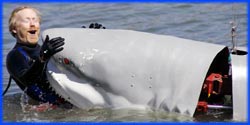


Premier Date: January 23, 2016
Each of the following myths was based on a viral video.
busted
Jamie chose an air cannon to propel the shrimp and built a pneumatic sprayer for the eggs, while Adam designed nozzles to launch and disperse the flour and bread crumbs. The final element was a device that generated a burst of flame to expose the shrimp to a temperature of 500 °F (260 °C). They set up all of the equipment as an assembly-line in an airplane hangar. The first several shrimp they launched disintegrated while leaving the cannon barrel, but fitting them into a paper cup (similar to a sabot on an artillery projectile) allowed them to travel downrange intact.
Once the aim was adjusted to hit the target consistently, they measured a flight time of 392 milliseconds and adjusted the timing on each component in the line. Eventually the shrimp went through each element on time, but at the end none were properly coated or cooked. Next, they replaced the flame rig with a 3 foot (0.9 m) long sword forge running at 2,100 °F (1,150 °C) and fired a fully-prepared shrimp directly through it, but found that its temperature still had not increased significantly. The same result occurred with a 12-foot (3.7 m) long forge, prompting them to declare the myth busted as the shrimp simply did not have enough time to absorb the heat needed for cooking.
plausible
Adam and Jamie built a blast-proof tank and filled it with water. They then positioned a shrink-wrapped tomato and a blasting cap near each other in the tank. After they set it off, Jamie was able to insert a straw in the undamaged skin and suck out a mouthful of juice, while Adam was unable to draw any from an intact tomato. They repeated this test several times and found that they could get more juice by moving the blasting cap closer to the tomato, and the tomato skin did not break until the blasting cap was positioned very close. Adam and Jamie ran a tomato through an industrial juicer at the shop and obtained a 62% juice yield based on its original weight. They measured a 33% yield upon draining the juice out of one of the tomatoes from their tests.
To investigate the use of larger amounts of explosive, they set up a new trial at a quarry pond, placing 20 pounds (9.1 kg) of TNT underwater at a depth of 10 feet (3.0 m). They then placed mesh bags containing one each of tomatoes, oranges, cucumbers, and pineapples at various distances from the explosives. After the explosion, they discovered that the surviving samples were either ruptured or tenderized, but they were not able to obtain any juice. They deemed the myth plausible based on the small-scale tests, and Jamie hypothesized that the use of the small tank allowed the shock wave from the explosion to reflect back and forth from the walls, repeatedly striking the tomato and more effectively juicing it.
Previous: Episode 239: Tanker Crush